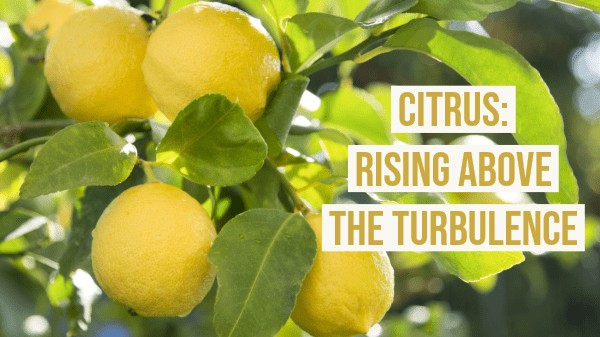The California citrus industry’s chief products are oranges, mandarins, and lemons, and it’s the nation’s number one fresh citrus supplier, providing about 80 percent of domestic supply; about 75 percent of its tonnage is sold domestically.
Total acreage is around 280,000 statewide, according to Joel Nelsen, the recently retired president of California Citrus Mutual, BB #:163392 Exeter, CA.
This number has been stable in recent years, although there are currently only around 260,000 producing acres because of orchard renovations.
“Citrus trees last 50 or 60 years,” Nelsen says. “A lot of trees in the San Joaquin Valley are past that peak production time.” As a result, some 20,000 acres are planted to “small nursery stock.”
The southern San Joaquin Valley is the chief citrus-producing region in the state, Nelsen notes, principally Tulare, Kern, and Fresno counties. There are nine citrus-producing counties in the state. Ventura, on the coast, chiefly produces lemons.
Other counties growing citrus include Riverside, Imperial, Monterey, and Madera. Orange County, which, as its name suggests, was once a center of the industry, now has a mere 71 acres planted to citrus.
Currently two issues are of main concern to the California citrus industry, Nelsen indicates. One is the perennial battle against pests and disease, particularly HLB. Up to this point, California has been lucky—“knock on wood,” says Nelsen.
So far, the disease has only been found in backyard trees in the state. (Unfortunately, in October a tree in nearby Tijuana, Mexico, was found to be infected with HLB. The U.S. Animal and Plant Health Inspection Service and the Baja Department of Agriculture burned the tree on site.)
The California citrus industry has taken a proactive stance toward the challenge. An HBL program is in place, using $15-18 million in grower money (the amount varies annually), $5-10 billion from the state, and $10-15 million from the federal government.
It includes a trapping and detection program, backyard inspections, public education, and “a massive amount of analysis,” says Nelsen.
In September a citrus industry owned high-security BSL-3 (biosafety level 3) lab was opened in Riverside, adjacent to UC-Riverside, at a cost of $8 million. The only other BSL-3 lab in the state is at UC-Davis, and “it’s oversubscribed,” Nelsen points out.
In labor, the California citrus industry is not seeing any shortages at this point, according to Nelsen, although the supply is definitely tighter; demand is tighter as well. “The demand for labor exceeds supply,” he says. “It’s frustrating.”
As for wages, harvesting is done on a piece-rate basis: laborers earn $100-200 a day. At packinghouses, entry level jobs are minimum wage, but people who work elsewhere earn “well over $20 an hour.”
Relations between labor and growers are good, says Nelsen, noting that the industry hasn’t seen any labor strikes.
“Packinghouse owners are very appreciative of their employees,” he says.
Although acreage has been fairly stable, Nelsen sees a trend toward consolidation of ownership. Frustrated by challenges such as increasing regulation, “many family farmers are selling out,” he observes, either to other family farms or to corporate entities.
This is particularly true when the younger generation is not interested in continuing as the older generation retires.
The newer generation that is remaining in the industry is far more “consumer conscious” than their elders, says Nelsen.
“The older generation produced an orange, and by God, you’re going to like it.” Since the turn of the century, the younger growers have introduced innovations such as growing clementines, which are now a major part of the industry.
Nelsen is particularly proud of the way the state citrus industry has been able to unite to face crises such as disease, pests, and freezes (the first significant one occurred in 1990). “When there’s a challenge, everybody comes together,” he stresses.
John Rast, president of Rast Produce Company, Inc., BB #:156829 a broker/distributor based in Visalia, sums up the situation from his point of view: “Our industry as seen a lot of consolidation both on the producing and also on the buying side in the past fifteen to twenty years. This has changed our business, and presented many challenges as consumers have many options when purchasing their groceries and/or meals. We feel that our role in this industry has gotten more important, with our experience and ability to deliver what is purchased, on time, and without problems. Our experience and the relationships we have built over many years, with both growers, shippers, and buyers is really now more important than ever as our business has gotten more complex and more competitive.”
This is multi-part feature on the U.S. citrus industry adapted from the January/February 2020 issue of Produce Blueprints.



